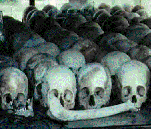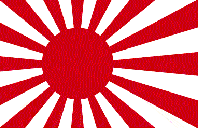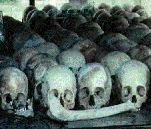Worldwide Terrorism & Crime Against Humanity Index
The Murders of Millions
Should Japan be allowed to expand the military after 2001?
The Nazi Attempts to Destroy the Jewish Race
The Japanese and German attempt to build the A-Bomb in WWII
Italian War Crimes of WWII
The Cambodian Killing Fields
On April 17th, 1975 the Khmer Rouge, a communist guerrilla group led by Pol Pot, took power in Phnom Penh, the capital of Cambodia. They forced all city dwellers into the countryside and to labor camps. During their rule, it is estimated that 2 million Cambodians died by starvation, torture or execution. 2 million Cambodians represented approximately 30% of the Cambodian population during that time.
The Khmer Rouge turned Cambodia to year zero. They banned all institutions, including stores, banks, hospitals, schools, religion, and the family. Everyone was forced to work 12 - 14 hours a day, every day. Children were separated from their parents to work in mobile groups or as soldiers. People were fed one watery bowl of soup with a few grains of rice thrown in. Babies, children, adults and the elderly were killed everywhere.
The Khmer Rouge killed people if they didnít like them, if didnít work hard enough, if they were educated, if they came from different ethnic groups, or if they showed sympathy when their family members were taken away to be killed. All were killed without reason. Everyone had to pledge total allegiance to Angka, the Khmer Rouge government. It was a campaign based on instilling constant fear and keeping their victims off balance.
After the Vietnamese invaded and liberated the Cambodian people from the Khmer Rouge, 600,000 Cambodians fled to Thai border camps. Ten million landmines were left in the ground, one for every person in Cambodia. The United Nations installed the largest peacekeeping mission in the world in Cambodia in 1991 to ensure free and fair elections after the withdrawal of the Vietnamese troops. Cambodia was turned upside down during the Khmer Rouge years and the country has the daunting task of healing physically, mentally and economically.







Japan used germ warfare across China
BEIJING (Aug 11, 1995) - China's Xinhua news agency said on Fridy that Japanese invaders waged germ warfare not only in occupied Chinese Manchuria in the 1930s but also in other cities, spreading cholera and plague among the people.
Xinhua, quoting research findings by Chinese and Japanese scholars at a symposium in the northern city of Harbin, said Japan's infamous 731 unit served as headquarters for live experiments on people in other parts of China.
"The Japanese unit 731, stationed in Harbin, experimented with various kinds of germs on live human bodies," Xinhua quoted Xin Peilin, deputy head of the History Research Institute of the Heilongjiang Academy of Social Sciences, as saying.
"Its headquarters was finally developed into the world's biggest germ warfare base, with 3,000 staff members and advanced facilities."
The scholars said the Japanese carried out germ warfare in Beijing, the central city of Nanjing, Dalian in the northeast and some regions of Southeast Asia.
Japan's imperial army, acting on secret orders from Emperor Hirohito, set up germ warfare units codenamed 731 and 100 to conduct experimental surgey on prisoners and test biological agents on them.
Chinese historians have estimated that more than 3,000 Chinese, Korean, Mongolian and Soviet citizens died in the programmes.
But the researchers, citing findings at a psychiatric hospital in Singapore, said the number of people killed by 731 unit could surpass 10,000, Xinhua said.
Japan set up similar germ warfare units in Beijing, Nanjing and Guangzhou, Xin said. "I can definitely point out the names and numbers of these units," he said.
He said the units concentrated on cultivating bacteria and carrying out experiments on human guinea pigs.
Xinhua said one germ warfare unit in Beijing openly announced it possessed enough cholera germs to kill the whole world and sprayed cholera germs in Beijing in August 1938, killing more than 300 people.
It said the diaries of Japanese officers at the units showed they conducted various biological experiments to produce plague germs that they sprayed on people in northeast China.
It quoted an unidentified Japanese professor as saying: "Japan once planned to wage germ warfare in the Philippines, Australia, Hawaii and Burma from 1942 to 1944, and it sanctioned germ warfare on Saipan and Guam in 1944."



Source: Global Alliance for Preserving the History of World War II in Asia















